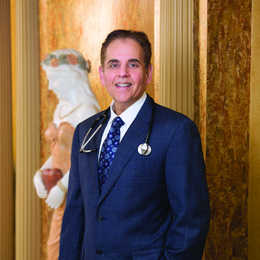
Every visit to your family physician includes the same routine checks of blood pressure and most likely some lab work on an annual basis. For the most part, these give doctors an overall view of a patient’s health, however, Dr. Vic Bahal, Integrative Cardiologist and founder of Advanced Cardiology of South Jersey, says these tests don’t go far enough in helping to identify things like hypertension and cholesterol levels. Unfortunately, this oversight could lead to undiagnosed conditions and puts patients at serious risk. Dr. Bahal spoke with Suburban Family about what your Physician may not be telling you about heart disease.
The Silent Killer
Hypertension, or High Blood Pressure, is known as the silent killer and increases the risk for heart disease, heart failure and stroke, among other things. It affects approximately one in three adults in the U.S., and in 2019, was a primary or contributing cause in the death of more than 500,000 people, according to the CDC. Hypertension gets its foreboding name because it shows little or no symptoms, and can easily be missed in a one-time reading at the doctor’s office.
“One blood pressure reading tells us nothing. There are several factors to consider to get the most accurate picture of a patient’s blood pressure,” Dr. Bahal says.
Normal blood pressure is 120/80. The top number is known as systolic pressure, the pressure in your blood vessels when your heart beats; and the bottom number measures the force of blood in your arteries while your heart is relaxed between beats, called diastolic pressure.
High blood pressure might be indicated when those numbers change, but the readings in a doctor’s office could be affected by certain factors during a patient’s appointment.
“There is something known as ‘White-Coat Hypertension,’ which means a person could have normal blood pressure at home, but when they come into the office, it’s high because they are worked up or nervous,” says Dr. Bahal. “There is another one called ‘Masked Hypertension,’ in which the blood pressure is high at home, perhaps due to work or personal stress, but normal at the doctor’s.”
Dr. Bahal also says blood pressure should dip naturally at certain times of day. He states, “Blood pressure should go down 10% at night and increase by 5% when you wake up. If it increases more than 20%, that would imply a dangerous situation. … Dramatic swings in blood pressure lead to endothelial dysfunction and cause damage to the inner lining of arteries. Once the inner lining is damaged, inflammation enters the vessel wall and causes plaque to form.”
The only way to get a full picture of a patient’s blood pressure is with remote monitoring, continues Dr. Bahal. Remote blood pressure monitoring is a new technology that Dr. Bahal is offering in his practice. This allows patients to take blood pressure readings at various points in the day—from their own home or workplace with a special computerized cuff provided to the patient—and the information is relayed electronically to Dr. Bahal, who now has a more accurate picture for treatment. It can also alert Dr. Bahal in real-time if a reading goes out of range and the patient may be at risk.
Lipid Panels
Another test that Dr. Bahal believes could be improved upon is the basic lipid panel ordered by most physicians. This measures the cholesterol and triglycerides in your blood.
“We go further and order an advanced lipid panel. Most physicians are not doing these. Lipid research has shown that we should be fractionating and looking at the LDL particle count and particle density. We know a higher LDL is bad, but it’s also bad if you have more density of LDL particles, even if the LDL level isn’t high itself,” Dr. Bahal says.
“Additionally, everyone assumes if you have a high HDL—good cholesterol—that it is cardio protective. But some HDL could be defective, meaning it’s not being effective in protecting you. This could be due to the enzyme myeloperoxidase. We have to check the blood for this through fractionation and looking for specific particles such as apolipoprotein B and HDL2b to get a better measure of risk for heart disease,” Dr. Bahal states.
Dr. Bahal orders other tests to look for signs of inflammation and stress, including a high-sensitivity C-reactive Protein (hs-CRP) test, 8-Hydroxy-2-Deoxyguanosine and Malondialdehyde (MDA). “Cholesterol is not necessarily a bad thing. It’s inflammation we need to worry about because that’s what forms plaque, and when we check into some of the above-mentioned markers, we can implement strategies to lower inflammation,” he says.
And as thorough as these tests are, that mantra carries through to how Dr. Bahal treats patients. While most people are just told to lose weight by their doctors, Dr. Bahal says they aren’t educated on what to “gain” in treatment, such as adding supplements and certain foods to their diet.
“I am a big proponent of supplements. I put a majority of my patients on CoQ10 and Alpha Lipoic Acid. These are powerful antioxidants that can reduce inflammation in the body. Vitamin D and K can help remove plaque from arteries, and I strongly support Fish Oil for reducing inflammation as well,” he says. Proper nutrition is important too, with the incorporation of dark fruits and red wine.
“Patients really have a knowledge void about these topics and I think most doctors aren’t going far enough in educating them about heart disease. I hope we can close that gap and provide them with a concrete plan for prevention,” Dr. Bahal concludes.
Advanced Cardiology of South Jersey
4 Burton Lane, Suite 100 | Mullica Hill
(856) 241-3838
AdvancedCardiologySJ.com
Photography by Alison Dunlap
Published (and copyrighted) in Suburban Family Magazine, Volume 13, Issue 5.
For more info on Suburban Family Magazine, click here.
For information about advertising in Suburban Family Magazine, click here.
To find out where to pick up your copy of Suburban Family Magazine, click here.




